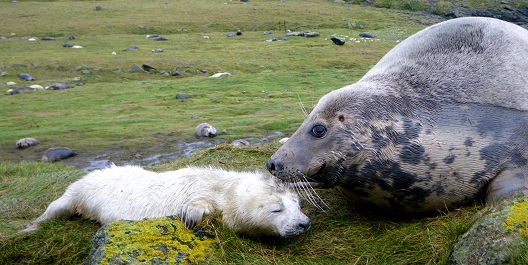Sealing the bonds between mother and child

Observations of mothering seals by scientists at the University of St Andrews has shed new light into the mother-child bond.
The new study, by Dr Kelly Robinson, found that the hormone oxytocin plays an important role in keeping seal mothers and pups physically close following birth.
Dr Robinson says that the findings, published by the journal PLOS ONE, could help understand the differences in maternal behaviour in humans, as well as seals.
The researcher, who studied grey seal breeding colonies on the North Atlantic island of North Rona, discovered the higher the levels of oxytocin in a mothering seal, the closer she stayed to her new pups.
Oxytocin, which is found in all mammalian mothers, has already been linked to optimal maternal behaviour – and a strong mother-child bond – in humans.
Dr Robinson is a research fellow at the University’s Sea Mammal Research Unit (SMRU). She said: “Mother-pup separation often results in starvation and is the largest cause of pup death in grey seals. Preventing separations between mothers and pups within a busy breeding colony is crucial for infant survival.
“The link between oxytocin and maternal behaviour not only has important consequences for pup survival in grey seals, but helps us understand why some individuals, including humans, are better mothers than others.”
During the two year study, Dr Robinson recorded the maternal care behaviour that grey seals showed towards their pups during the rearing period. Blood samples, to determine levels of the hormone, were also collected from these mothers.
The distance individual mothers strayed from their pups ranged between 0 and 30m, but those that kept closest to their pups had the highest oxytocin concentrations. As the amount of oxytocin in a mother’s blood decreased, the distance they were from their pup increased.
Dr Robinson explained: “Some grey seal mothers are much better at raising pups than others, even when allowing for differences in the mother’s age and size and, as a result, some pups on a breeding colony die while others thrive. Studying the role of oxytocin, a hormone that regulates maternal behaviour, offers some insights into why such differences in individual behaviour occur.
“Oxytocin has been linked to optimal maternal behaviour in humans and many captive animal species, but this is the first time such a link has been shown in completely wild animals in their natural habitat.”
The study, which was carried out with researchers at Durham University, is published online by PLOS ONE.
Note to editors:
Dr Robinson is available for interview via: 01334 462635 or email [email protected].
Grey seals only spend 18 days feeding their infants before mothers return to sea and wean their pups; their lactation period is among the shortest of any mammal. As a result, pups must drink as much fat-rich milk as they can to build up their energy reserves before their mothers leave the colony. The fatter the pup, the better the chance it has of surviving the first year of life at sea.
Note to picture editors:
Images are available from the press office – contacts below.
Issued by the Press Office, University of St Andrews
Contact Gayle Cook, Senior Communications Manager, on 01334 462530 or email [email protected].
Ref: Maternal seals 04032016
Category Research